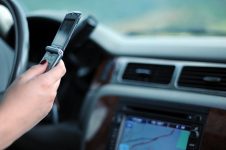Mobile Phone Use Sparks Road Rage

The dangers of driving while distracted have been well documented, but have road safety organisations gone too far in convincing people of the dangers of driving and texting, or talking on the phone?
It would appear that the message has got through so effectively that vigilantes are springing up across the country, photographing drivers they see engaging in distracting activities and reporting them to police.
Driving while using a mobile phone is a traffic offence across Australia, and it’s one that has gained widespread attention in recent years. The penalty for using a phone while driving in NSW is a $311 fine and three demerit points.
Figures from NSW show that the number of people being issued traffic infringement notices for mobile phone use is decreasing, but there are still angry reactions from some motorists when they see others using their phones.
Victorian vigilantes on the rise
In Victoria, there have been reports of incidents where motorists, pedestrians and cyclists have displayed angry or aggressive behaviour to drivers they see using their mobile phones and holding up traffic, or driving erratically as a result.
According to police, people are sending in footage and photos of drivers doing the wrong thing and using phones while behind the wheel, sometimes leading to charges being laid.
This spate of aggressive incidents has led police to warn motorists of the dangers of confronting other drivers given the potential for situations to escalate, and cause accidents or injury.
The Victorian government increased the fine for using a mobile phone while behind the wheel in that state to $433 in 2013, and also upped the number of demerit points from three to four for drivers caught talking or texting.
While the number of people being fined for mobile phone use has decreased in Victoria, the number of road rage incidents has risen recently.
Road rage can be dangerous, as in the case of Perth driver Michael Craig Anderson who was found guilty of shooting at another driver at high speed as a result of a minor collision. The court heard that Mr Anderson was frustrated because the car in front of him was driving slowly to conserve fuel so he overtook, then slammed on the brakes to cause a small collision.
The other driver became concerned and overtook Mr Anderson’s car after which he did the same thing. The second time the driver tried to overtake him, Mr Anderson leaned out of the window and aimed a gun at him, firing at least five shots, one of which hit the petrol tank of the other car. Mr Anderson was given a sentence of 14 years in prison for his actions.
Is evidence against drivers from the public enough to convict?
A mobile phone snapshot of a driver texting or talking on their mobile phone may not be sufficient for police to lay charges, and there is a danger that vigilante drivers could be putting themselves and the public in danger for no benefit by taking them.
With the increasing popularity of dashboard cameras, more people are capturing footage of bad driving and accidents that they encounter along the way.
These images are becoming so common that there’s even a Facebook page set up for motorists to share the footage of other drivers and comment on it.
Sending images to police can sometimes result in a conviction as in the case of a passenger on a minibus in Victoria who photographed a woman driving a car with a dog on her lap while texting. The police were able to identify the vehicle from the licence plates, and fined her $885 and four demerit points.
Generally the evidence to convict a driver on the basis of a photo or image needs to be fairly significant and the vehicle registration details need to be clearly visible.
What is the problem with recording dangerous drivers?
The warning issued to the public from Victoria Police focuses on the risk of confrontation due to road rage, but also on the dangers of drivers who may use their own mobile phone to photograph other motorists while driving.
Inspector Simon Humphrey of the Road Policing Command suggests that motorists focus on their own driving rather than becoming distracted by the behaviour of other motorists, or risking confrontations that could become dangerous.
Police are believed to be considering setting up a hotline for drivers to report incidents of mobile phone use, texting or other dangerous driving that they witness when they are on the road.
This could give vigilante drivers a means of reporting dangerous driving and increase the likelihood that their complaints will be acted on.
If you have been accused of a traffic offence such as using a mobile phone behind the wheel, and you don’t believe the allegations are fair, contact an experienced traffic lawyer in Sydney as soon as possible. A lawyer can evaluate the evidence against you, and help you apply to have matter withdrawn or thrown out if the evidence against you isn’t strong enough.
Going to court for a traffic offence?
If you are going to court for a traffic offence, call or email Sydney Criminal Lawyers anytime to arrange a free first consultation with an experienced, specialist traffic lawyer who will accurately advise you of your options, the best way forward, and fight for the optimal outcome in your specific situation.






